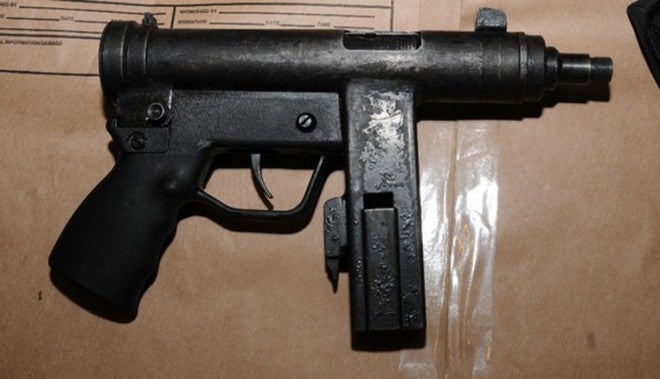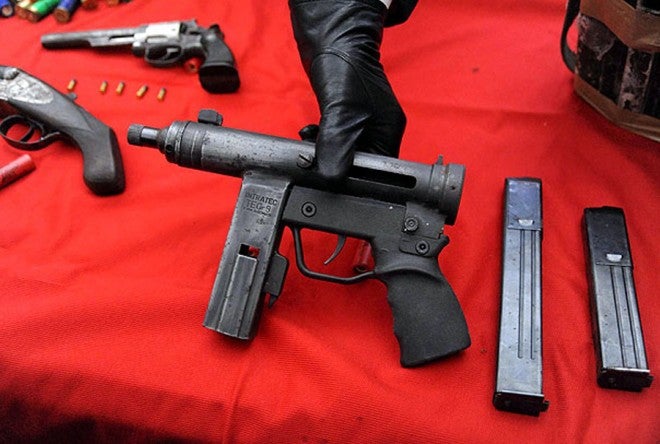Whatever one thinks of the proliferation of firearms, it’s a fact that the technology needed to make reliable, effective weapons is well in hand. Even at the lowest levels of industrial capability firearms are practical, manufacturable items, and this includes those capable of fully automatic fire. Weapons with a great deal of firepower can be made from simple, off-the-shelf items at home. Proof of this can be seen in the numerous improvised firearms that continually turn up all over the world.
ImproGuns, who contributes to this site, recently published an article on a weapon made to an extremely high standard; an illicit machine gun that turned up in large numbers in Croatia, as well as in Holland and the UK. Following that, he also wrote about a different firearm made to nearly as high a standard as the first. Either weapon is small, concealable, and capable of unleashing fully automatic firepower. How can you keep such weapons out of the hands of criminals? simply, there is no way, besides locking up the criminals themselves.

A simple weapon, made cheaply and inexpensively in a clandestine shop. With the addition of a magazine, which is itself no more than a box with a spring in it, and some cheap and easily acquired or manufactured ammunition, it can put out lethal firepower reliably. Image source: armamentresearch.com
Weapons like the one above are no more than simple tubes with a minor amount of welded sub-assemblies, and trigger mechanisms that amount to nothing more than a bar blocking the bolt from going forward. The heart of their mechanism is a mass on a spring, no more complex than the simplified oscillation diagrams in a high school physics textbook, with a protruding, fixed pin at the front to detonate the primers of cartridges. There are no complex internal sub-assemblies, nothing requiring precision machining, and every single component can be made in a garage by unskilled labor. These kinds of weapons were perfected in WWII, but people have been “rolling their own” well before that, and many, many of the most famous gun designers (one of whom was, himself, a cop-killer and an outlaw, Williams was for the record a distinct outlier among gun designers) got their start making improvised weapons at home, before turning their talents towards the pursuit of designing and making factory firearms.
In that second of the World Wars, a weapon was devised that was so simple, scuttlebutt has it that it took longer for a shooter to load one than it did for the factory to make it. The cost per unit of that FP-45 Liberator was, at the time, only $2.40 a unit, or a little over $30 in today’s money. The single-shot Liberator was designed as a weapon to be dropped in large quantities all over Europe for partisans to use against the occupying German forces, but even it was not so much cheaper than the existing fully automatic 9mm Sten submachine gun, that the latter eventually was chosen instead as the weapon that would arm Europe for its liberation. Either weapon is a model for the home-builder, and those few with the legal sanction to do so have often chosen the Sten, or something equally simple, as their first fully automatic weapon to manufacture legally.
When the conversation turns to guns, my father is fond of saying “the genie is out of the bottle”. No matter what laws or regulations are in place, the technology to make firearms from readily available materials and simple processes is in-hand, and nothing short of total de-industrialization can turn that clock back. Examples of the unleashed genie abound; a recent trip to the National Firearms Museum had me beholding weapons made by Vietnamese Communists out of tubes and boards, with dubious firing mechanisms. Beyond this crude level of work, [Advisement: The following links will take you to Amazon pages for volumes on how to make your own fully automatic firearms; these are illegal in many countries, and in the United States if you do not possess a Type 2 SOT, and there is a chance that law enforcement may perceive the purchase of these volumes as a precursor to criminal activity – having said that, they are all on my Amazon wish list] many volumes have been written detailing the construction of simple, pistol-caliber blowback submachine guns. As long as suitable ammunition is available, it is very difficult to prevent the manufacture of relatively modern, effective fully automatic weapons, as they can be produced in almost any shop or garage capable of even basic fabrication.
Even without ready sources of quality ammunition, propellants, primers, and cartridge casings can be produced from scratch given even modest industriousness, let alone industrial facilities. Earlier, we ran an article on YouTuber Cody’s successful effort to make homemade blackpowder – and even selfloading weapons can be made to function with ammunition loaded with blackpowder:
Moving forward, it must be recognized that firearms are here to stay. The road to such a level of de-industrialization as to make the cheap manufacture of highly capable firearms impractical is a long, and bloody one, and the future after that is dull and brutish. It’s an unfortunate fact that many bad men are creative. The world would be a safer place if all evil men were slackjawed australopiths, little more than upright apes that could scarcely grasp the magic of man-made fire, much less the complexities of modern industrial technology, but creativity seems to be a nearly universal trait among humans, good and bad.
 Your Privacy Choices
Your Privacy Choices
